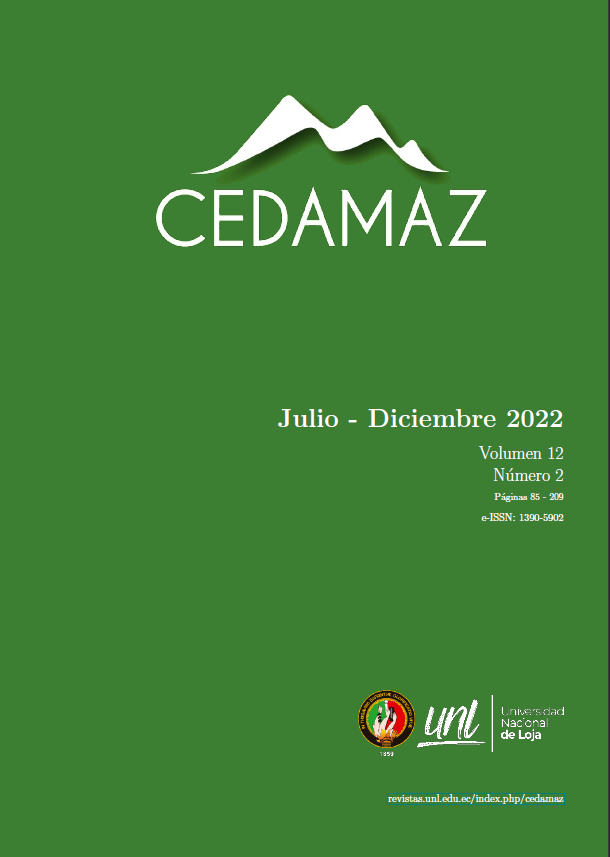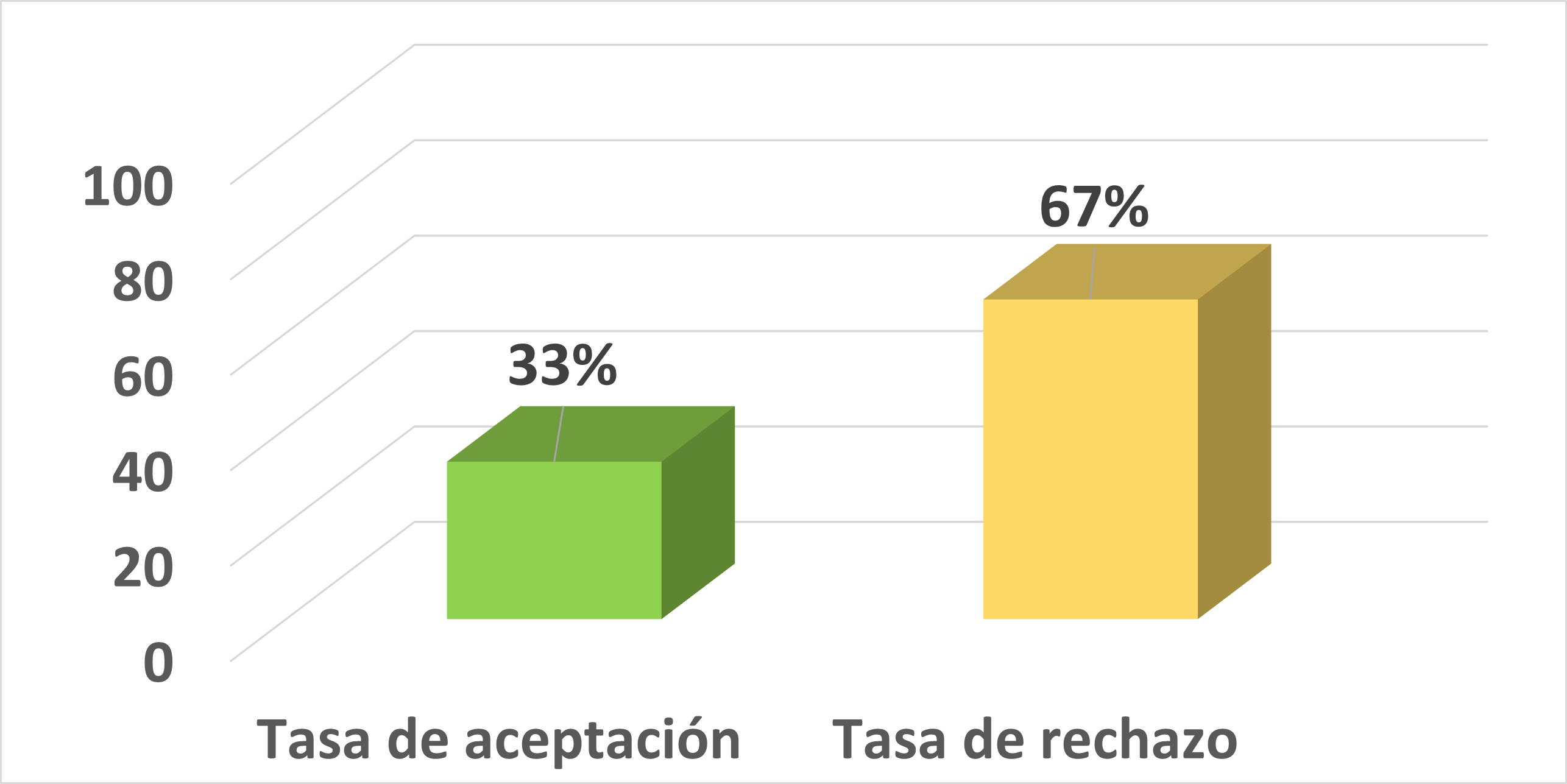Influence of pruning and nitrogen nutrition on the vegetative development of blueberry (Vaccinium corymbosum L. cv. Biloxi)
DOI:
https://doi.org/10.54753/cedamaz.v12i2.1325Keywords:
Vaccinium corymbosum L. cv Biloxi, Management techniques, Ammonium sulfate, Nitrification inhibitorAbstract
The cranberry is a fruit tree of great economic importance worldwide, due to its high demand and the multiple benefits it confers to human health. In Ecuador, management techniques such as pruning and fertilization during the vegetative stage are little known. Based on this, the objective of the present research was to evaluate the vegetative development of blueberry (Vaccinium corymbosum L. cv Biloxi) subjected to two pruning intensities and different sources of nitrogen nutrition, one of them with nitrification inhibitor; on morphological and physiological variables of the plants, the pH and electrical conductivity (EC) of the soil. The trial was established at the Quinta Experimental Docente "La Argeliaïn the city of Loja, under an experimental design of completely randomized divided plots, with 4 treatments and 6 replications, the plot being the pruning factor (with 4 arms and without pruning) and the subplot the fertilization (ammonium sulfate with and without nitrification inhibitor). The results showed that the interaction between the pruning factor and nitrogen fertilization was null; the fertilization factor acted independently on morphological variables such as shoot length, plant cover, and shoot leaf area. The data indicated that the supply of ammonium sulfate with inhibitor promoted vegetative growth to a greater extent, while ammonium sulfate without inhibitor increased nitrogen content in the leaves. These results suggest that ammonium nitrogen supply with nitrification inhibitor promotes the development of blueberry cv. Biloxi plants. On the other hand, soil pH and electrical conductivity (EC) were altered by the application of nitrogen nutrition sources. Key words: Vaccinium corymbosum L. cv Biloxi, nitrification inhibitor.References
ASOEX. (2021). Exportaciones chilenas de arándanos orgánicos aumentan un 25%. Fresh Plaza.
Bañados, P. (2005). Claves Para la Poda de Arándanos: Temporada de Invierno. Agronomía y Forestal UC, 28–31.
Barbaro, L., Karlanian, M., Mata, D. (2012). Importancia del pH y la Conductividad Eléctrica (CE) en los sustratos para plantas. Ministerios de Agricultura, Ganadería y Pesca.
Crisóstomo, M. ., Hernández, O. ., Lópes, J. ., Manjarrez, C. ., Pinedo, A. (2014). Relaciones Amonio/Nitrato en Soluciones Nutritivas Ácidas y Alcalinas para Arándano. Revista mexicana de ciencias agrícolas.
Doyle, J., Nambeesan, S., Malladi, A. (2021). Fisiología de la nutrición de nitrógeno y calcio en arándanos. 2.
Fang, Y., Williamson, J., Darnell, R. (2017). Absorción y asignación de nitrógeno en diferentes etapas de crecimiento de plantas jóvenes de arándano alto del sur. HortScience, 52 (6), 905–906. DOI: https://doi.org/10.21273/HORTSCI11723-17
Frías, C., Santiago, G., Montoya, R., Juárez, C. (2020). Concentración de la solución nutritiva y su relación con la producción y calidad de arándano azul. Ciencia y Tecnología Agropecuaria, 3–6.
Fruniss, G. (2005). Comparación de dos fertilizantes como fuente de N amoniacal, y sus efectos sobre el crecimiento de limoneros.
Garzón, D. (2021). Diego Garzón, Presidente Fepexa. Prensa Ec.
González, P. (2018). Un Pionero en Cultivar Arándano.Revista Líderes.
Hernández, D. (2014). Estudio Nutrimental de Arándano Azul (Vaccinium corymbosum L.) cv. Biloxi en los Reyes, Michoacán. Instituto de Enseñanza e Investigación en Ciencias Agrícolas.
Jiang, B., Li, Y., Tsao, R., Miao, M. (2014). Food Safety: Food Analysis Technologies/Techniques. En Food Safety: Food Analysis Technologies/Techniques (pp. 273–288). DOI: https://doi.org/10.1016/B978-0-444-52512-3.00052-8
Kalt, W., Cassidy, A., Krikorian;, R., Tremblay;, F., Zamora-Ros, R. (2020). Recent Research on the Health Benefits of Blueberries and Their Anthocyanins. Advences in Nutrition, 11, 224–236. DOI: https://doi.org/10.1093/advances/nmz065
Kramer, J. (2020). Fresh Blueberry Supplies Expand as U.S. Consumers Develop a Taste for Year-Round Blueberries. Economic Research Service U.S. Department of Agriculture.
Lallana, V., Lallana, M. (2004). Fisiología Vegetal: Crecimiento. 3–7.
Lima, Firmino; Carvalho, Márcio; Soares, Gabriel; Kiyoshi, Osvaldo; Divino, Elias; Rodrigues, A. (2020). Ecofisiología del arándano Southern Highbush cv. Biloxi en respuesta a la fertirrigación con nitrógeno. Horticultural Journal: Comunicata Scientiae.
Mendoza, C., Ojeda, W., Ramírez, C., Flores, H. (2017). Estimación del índice de área foliar y rendimiento de chile poblano cultivado en invernadero. Ingeniería Agrícola y Biosistemas.
Mesa, P. (2015). Algunos aspectos de la fenología, el crecimiento y la producción de dos cultivares de arándano (V. corymbosum y V. darrowii) plantados en Guasca (Cundinamarca, Colombia). 37,39,45,47.
Osorio, R., Covarrubias, J. (2019). Vegetative and Physiological Responses of “Emerald” Blueberry to Ammoniacal Sources with a Nitrification Inhibitor. Journal of Soil Science and Plant Nutrition, 2–8. DOI: https://doi.org/10.1007/s42729-019-00135-7
Pinochet, D., Artacho, P., Maraboli, A. (2014). Manual de Fertilización de Arándanos Cultivados en el Sur de Chile (U. A. de Chile (ed.)).
Prince, C., Munns, R. (2011). Capítulo 6. Análisis del crecimiento: un enfoque cuantitativo. School of Plant Biology, University of Western Australia, 1–6.
Puga, J. (2019). Estudio de Factibilidad Para la Creación de la Empresa “ARANDEANBLUE”, Productora y Comercializadora de Arándano, Ubicada en el Sector de Chaquibamba, Provincia de Pichincha. Repositorio ESPE.
Redagrícola. (2021). El arándano peruano sigue quebrando sus récords. Redagrícola.
Retamales, J., Hancock, J. (2012). BLUEBERRIES (CABI (ed.); Crop Produ) DOI: https://doi.org/10.1079/9781845939045.0000
Rivadeneira, M. (2012). Concentración de nutrientes en hojas de diferente estado de desarrollo en arándano. 247–250.
Rodríguez, A. (2014). Manejo de la Fertilización en el Cultivo del Arándano, Experiencias del Seguimiento Nutricional en Perú. AGQ LAbs: Seguimiento y Control Nutricional.
Sinavimo. (2019). Vaccinium corymbosum. Sistema Nacional Argentino de Vigilancia y Monitoreo de Plagas.
Turnbull, L;; Victor, C;; Purves, B. (2008). Tasas de crecimiento, tamaño de las semillas y fisiología: Las especies de semillas pequeñas crecen realmente más rápido. Ecological
Society of America.
Published
How to Cite
Issue
Section
License
Copyright (c) 2022 CEDAMAZ

This work is licensed under a Creative Commons Attribution-NonCommercial-NoDerivatives 4.0 International License.
Those authors who have publications with this journal, accept the following terms:
- After the scientific article is accepted for publication, the author agrees to transfer the rights of the first publication to the CEDAMAZ Journal, but the authors retain the copyright. The total or partial reproduction of the published texts is allowed as long as it is not for profit. When the total or partial reproduction of scientific articles accepted and published in the CEDAMAZ Journal is carried out, the complete source and the electronic address of the publication must be cited.
- Scientific articles accepted and published in the CEDAMAZ journal may be deposited by the authors in their entirety in any repository without commercial purposes.
- Authors should not distribute accepted scientific articles that have not yet been officially published by CEDAMAZ. Failure to comply with this rule will result in the rejection of the scientific article.
- The publication of your work will be simultaneously subject to the Attribution-NonCommercial-NoDerivatives 4.0 International (CC BY-NC-ND 4.0)









